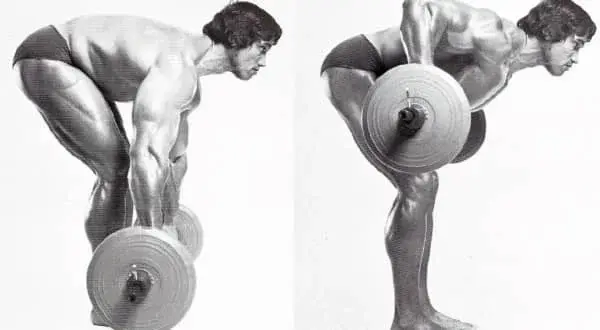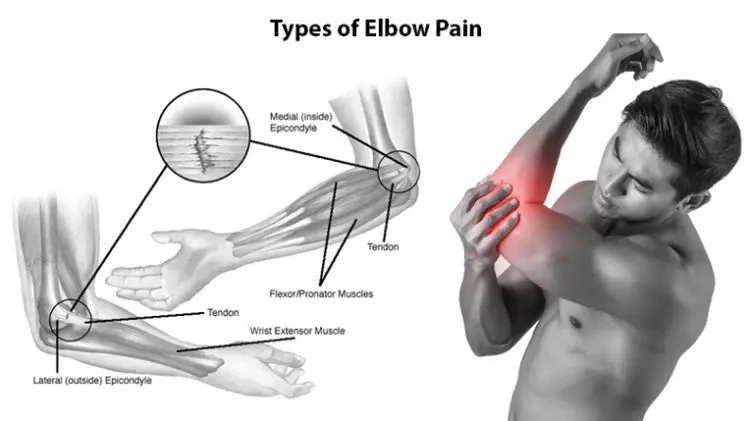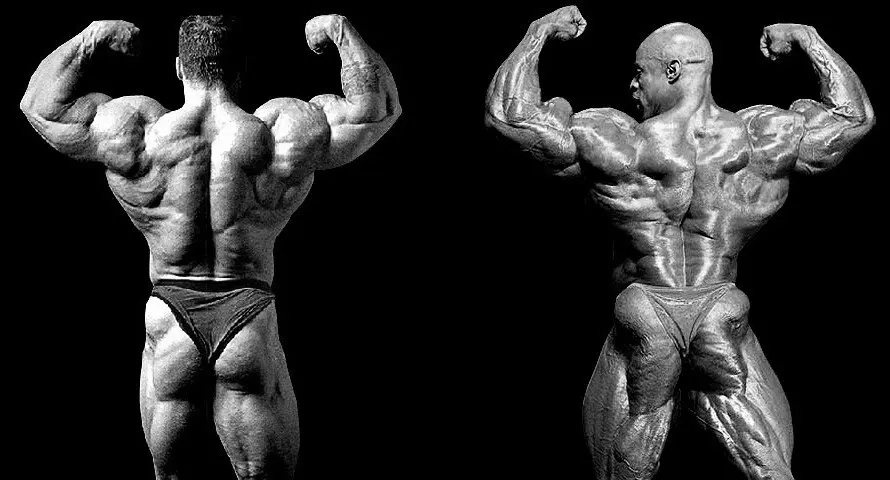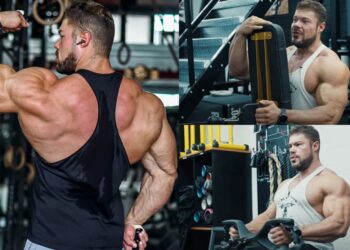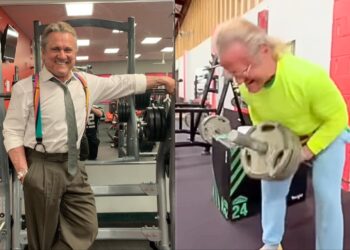There are two main ways to train your back – shoulder adduction exercises like pull-ups and pull-downs, and shoulder extension exercises, which are all rowing variations. If you want to build a thick, broad, powerful back, you need both types of exercise in your training plan.
When it comes to rowing exercises, there are dozens to choose from, and, depending on your training goal, they can all be useful and beneficial. However, two rowing variations really stand out – Kroc rows and Pendlay rows. Both of these exercises are decidedly hardcore and are renowned for being super-effective.
But, which one is best?
In this article, we compare these two monster back builders so you can choose the right one for you. But, before we put these exercises to the test, let’s take a moment to ensure you are familiar with both of them.
Kroc Row Basics
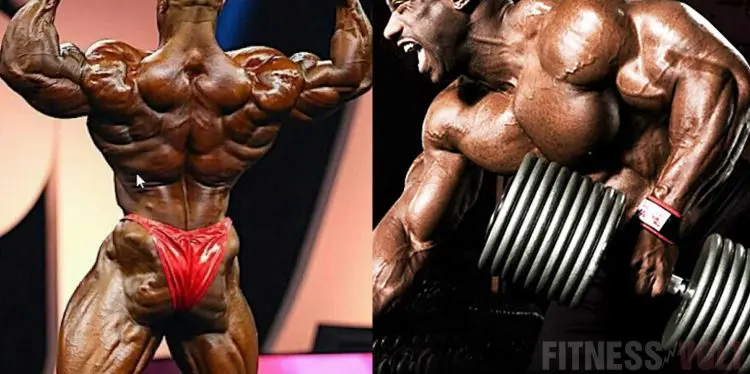
Kroc rows are named after powerlifter Matt Kroczaleski. They are a type of high rep, heavy weight one-arm dumbbell row. Unlike regular one-armed rows, Kroc rows employ a little momentum to keep the weight moving. While this IS a form of cheating, it’s part and parcel of this exercise and is what allows you to lift heavy weights for high reps.
Level Up Your Fitness: Join our 💪 strong community in Fitness Volt Newsletter. Get daily inspiration, expert-backed workouts, nutrition tips, the latest in strength sports, and the support you need to reach your goals. Subscribe for free!
Kroc rows will help you build a thick, powerful back. They also work your biceps and can help you develop stronger hands and bigger forearms. That said, to crank out as many reps as possible, a lot of Kroc rowers use wrist strips to reinforce their grip.
Check out this video to see powerlifter Jim Wendler, the inventor of the 5/3/1 training program, doing a set of Kroc rows with a massive 210lbs dumbbell.
As you can see, Wendler uses his legs and back to pull the weight up, but the movement is still reasonably controlled, and his tempo remains constant for the entire set.
How to do it:
- Hold a heavy dumbbell in one hand and stand with your feet about shoulder-width apart and one foot in front of the other.
- Lean forward and place your supporting hand on a stable bench, dumbbell rack, or similar.
- Brace your core to stabilize your spine and pull your shoulders down and back.
- Initiating the movement with your legs and hips, pull the dumbbell up and into the side of your abdomen. Do not round your lower back.
- Lower the weight and repeat, trying not to pause between reps.
Pendlay Rows Basics
Pendlay rows get their name from Olympic weightlifting and powerlifting coach Glenn Pendlay. This exercise is a bent-over barbell row where each rep starts from the floor. Because of this, Pendlay rows are sometimes called dead-stop rows.
Pendlay rows are a relatively strict exercise. Starting each rep from a dead stop means it’s much harder to use momentum to lift the weight. Resting the bar on the floor also gives your lower back a rest between reps, which means you should be able to do more reps or lift heavier weights than with regular bent-over rows.
How to do it:
- Start with your barbell on the floor. Stand with your feet about hip to shoulder-width apart, toes under the bar.
- Bend your knees slightly, hinge forward from the hips, and bend over until your upper body is parallel to the floor.
- Grab the barbell with an overhand, slightly wider than shoulder-width grip. Tuck your chin in and lengthen your neck; do not lift your head and look forward or allow your lower back to round.
- Brace your core, pull your shoulders down and back, and pull the bar up into your abdomen. Keep your upper arms tucked in close to your sides. Your upper body should remain stationary throughout.
- Lower the barbell back down the floor and allow it to settle. Reset your core and repeat.
Watch Enrique Santatecla from Fitness Volt demonstrate the correct pendlay rows below:
Now you know how to do these powerful exercises correctly, let’s compare them and see which one comes out on top!
Kroc Rows vs. Pendlay Rows – Learning Process
How easy is it to learn how to do these two exercises? After all, even if you are an experienced lifter, any new movement can leave you feeling like a beginner. Where do Kroc rows and Pendlay rows fall on the technical difficulty scale, and how quickly will you master your chosen lift?
Pendlay rows involve unsupported forward flexion of the spine. This requires good flexibility and excellent core strength. You’ll also need a high degree of positional awareness to monitor and control your lumbar spine, ensuring that it remains neutral at all times.
In contrast, with Kroc rows, you use a bench and your free arm to support your torso, which takes stress off your lower back. Kroc rows are performed using one arm at a time; you have less to think about as you pump out the reps.
This exercise is also done with fairly loose form, so you don’t have to use such controlled, precise movements. Most lifters are also very familiar with regular single-arm rows, so they’re already well on their way to learning this exercise.
Winner: Kroc Rows
Kroc rows provide more instant gratification than Pendlay rows. Pendlay rows are technically demanding, which means most lifters will find them more challenging to master than Kroc rows. Initial workouts will probably involve using lighter weights and working on technique, meaning this exercise won’t be very beneficial at first.
In contrast, most beginners should pick up Kroc rows much faster. Because they’re simpler to perform, you should be able to start using heavy weights more quickly, so you can begin reaping the benefits of this exercise sooner.
Kroc Rows vs. Pendlay Rows – Equipment and Long-Term Progression
Both Kroc rows and Pendlay rows use readily available training equipment. Even if you train in a garage gym, you should have everything you need to do both these exercises. You don’t need an extensive rack of dumbbells for Kroc rows – a single loadable dumbbell handle will suffice, and any old barbell will work for Pendlay rows.
However, in terms of progression, you may find that, in time, you can rep out even the heaviest dumbbells in your gym. You can use a loadable dumbbell, but even then, there is a limit to how much weight you can safely fit on a dumbbell handle. You could also buy an extra-heavy dumbbell just for Kroc rows, but what happens when you get too strong for that one? It becomes redundant, and you’ll need another one.
Level Up Your Fitness: Join our 💪 strong community in Fitness Volt Newsletter. Get daily inspiration, expert-backed workouts, nutrition tips, the latest in strength sports, and the support you need to reach your goals. Subscribe for free!
Pendlay rows are much less limiting. After all, most barbells can hold 500lbs or more, and you can use small denomination plates to gradually increase your weights over time. It’s doubtful that you’ll ever be able to Pendlay row more weight than you can put on a barbell.
Winner: Pendlay Rows
While you may eventually outgrow your Kroc row dumbbells, that isn’t going to happen with barbell Pendlay rows. Unless you are prepared to buy a selection of very heavy dumbbells, Pendlay rows are best for long-term progression. That said, it’s probably going to be a while before you can crank out 20+ reps with a 100lbs dumbbell, so don’t write this exercise off too soon!
Kroc vs. Pendlay Rows – Safety
Safety is an important factor when choosing exercises for your workouts. Ideally, you want to pick the movements that provide the greatest benefits with the lowest amount of risk, and that risk must be justifiable.
Kroc rows and Pendlay rows are similarly effective and have a similar level of risk, although that risk comes from different sources.
The risk during Kroc rows comes from the momentum and loose technique normally associated with this exercise. Combined with the heavy weights and high reps, Kroc rows can cause elbow, shoulder, and lower back injuries.
Some of that risk is mitigated by using a bench for support and exercising some common sense along with your muscles, i.e., not using too much weight too soon and stopping your set before your form completely breaks down.
Pendlay rows are done with more control, but the unsupported forward flexion puts a lot of stress on the lower back. However, resting the bar on the floor between reps reduces back fatigue and provides you with the opportunity to reset your core and correct your position.
Winner: Pendlay Rows – but only just!
Providing you can maintain a neutral spine throughout your set, Pendlay rows should be marginally safer than Kroc rows. But, if you cannot brace effectively and find your lower back keeps rounding, Kroc rows could be the safer choice because you can use your free arm to support your torso. Of course, any exercise done with too much weight or poor form could result in injury, including Kroc and Pendlay rows.
Kroc vs. Pendlay Rows – Hypertrophy and Strength
Both Kroc and Pendlay rows can help you build bigger muscles and increase your strength, especially if you are a training novice or new to either of these exercises. But, because of things like time under tension, peak force, and tempo, their primary effects are slightly different.
Kroc rows are typically done using heavy weights for high reps, leading to a lengthy time under tension. Time under tension is a crucial factor for hypertrophy. In addition, that muscular tension is pretty constant as each rep transitions smoothly into the next; there are no pauses. Finally, a set of high-rep Kroc rows will leave your upper back and biceps pumped. As all bodybuilders know, a good pump can help you build muscle faster.
In contrast, a set of Pendlay rows is more like a series of single reps punctuated by deliberate pauses. Reps are done explosively but with control. This reduces time under tension. The brief break between reps also minimizes metabolic stress, so there won’t be such a noticeable pump.
However, Pendlay rows allow you to use very heavy weights, meaning they are potentially better for increasing strength and power. The unsupported position of Pendlay rows also means this exercise works the entire posterior chain. In contrast, Kroc rows are more of an upper-body workout.
Hypertrophy winner: Kroc Rows
Strength winner: Pendlay Rows
Pendlay rows are often used as an accessory exercise in Olympic lifting and powerlifting. It helps develop lower and upper back strength. In contrast, bodybuilders often use Kroc rows to build back mass.
There is some crossover between these exercises, and Kroc rows will make you stronger, and you can use Pendlay rows to build muscle mass. But, if you have a specific training goal and need to choose between building strength or size, pick the right tool for the job to get better results from your training.
Kroc Rows vs. Pendlay Rows – Wrapping Up
On paper, Pendlay rows are our winner, scoring three wins compared to two for Kroc rows. But that slender victory doesn’t really reflect the most important consideration when choosing the right exercises for your workouts – which is the best option for YOU?
For example, if you want to build back strength, are a technically proficient lifter, and want to row for increased powerlifting or Olympic weightlifting performance, the best exercise for you is probably the Pendlay row.
But, if you want an exercise that you can pick-up almost instantly and want to build muscle size while also getting stronger, maybe Kroc rows are the best choice.
If you STILL aren’t sure which is better, try a month of Kroc rows followed by a month of Pendlay rows. Measure your progress and decide for yourself which is the right exercise for you. After all, your body is your laboratory, and it’s only through self-experimentation that you’ll discover the best way to train for your goals.
You may not even NEED to choose between these two great exercises. Why not use them both to build the back of your dreams!
Interested in measuring your progress? Check out our strength standards for Pendlay Row, Pull Ups, Dumbbell Row, and more.

